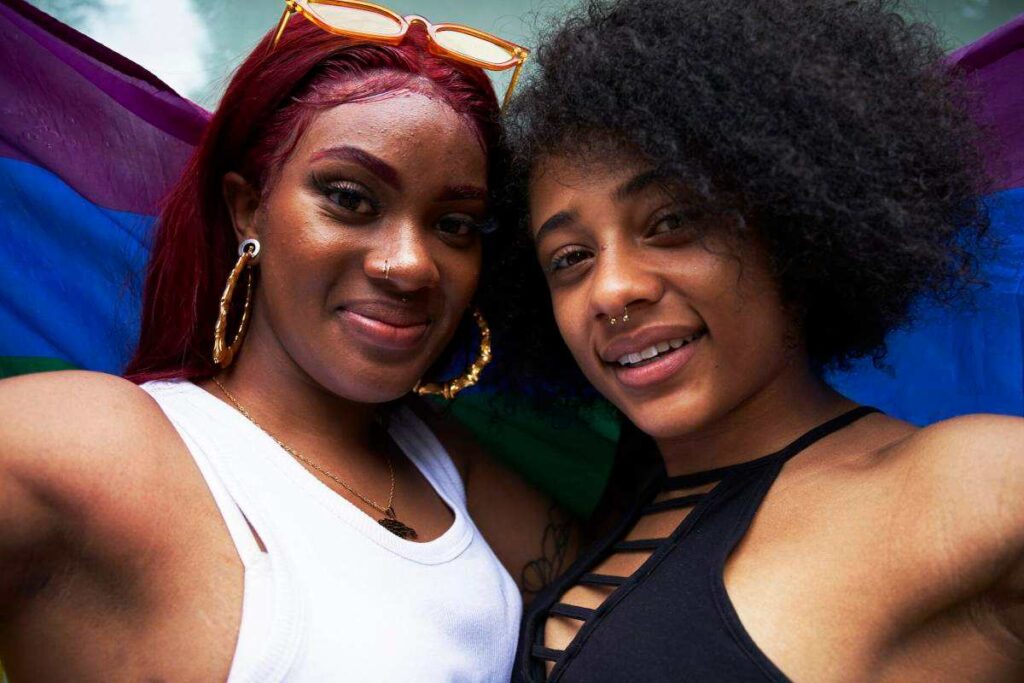Through this blog, we will shine a light on what it means to identify as semi-bisexual, how it intersects with other identities, and the nuanced conversations that surround it. We will tackle commonly asked questions, and misconceptions, and share the experiences of those who identify as semi-bisexual. Our aim is to foster a sense of understanding and acceptance and to celebrate the diversity of human sexuality.
Contents
What Does Semi-Bisexual Mean?
 Semi-bisexual isn’t a term that’s officially recognized or commonly used within the broader LGBTQ+ community or professional sexual health resources. Therefore, it doesn’t have a precise, universally accepted definition.
Semi-bisexual isn’t a term that’s officially recognized or commonly used within the broader LGBTQ+ community or professional sexual health resources. Therefore, it doesn’t have a precise, universally accepted definition.
However, in informal contexts or personal discourses, some individuals might use the term “semi-bisexual” to describe their unique experiences of sexual or romantic attraction. In general, bisexuality is a sexual orientation where a person can be attracted—either physically, romantically, or sexually—to more than one gender. The term “semi-” typically means “half” or “partially,” which could suggest that a person identifying as “semi-bisexual” might experience these attractions in a limited or specific manner.
For instance, some people might use “semi-bisexual” to describe a situation where they predominantly feel attracted to one gender. But still occasionally experience attraction to other genders. Alternatively, it could be used to describe a situation where someone’s attraction to different genders is conditional—dependent on specific factors. That might include emotional intimacy or relationship status.
Again, it’s important to stress that because “semi-bisexual” is not a widely recognized term, its meaning can vary widely from person to person. If you encounter someone who identifies as “semi-bisexual,” it’s best to ask them politely to explain what that term means to them. This encourages open, respectful conversations and helps to expand our understanding of the vast spectrum of human sexuality.
How Are Semi-Bisexual And Bisexual Different?
“Bisexual” is a well-established term within the LGBTQ+ community. And is generally understood to mean an attraction to both one’s own gender and other genders. This attraction does not have to be equally split between genders and can fluctuate over time.
“Semi-bisexual”, on the other hand, is not a widely recognized or standardized term within the community. Thus, it doesn’t have a universally accepted definition. However, based on its construction, the term could be used by some individuals to describe a situation where they feel partially bisexual. Perhaps experiencing attraction to their own and other genders under specific circumstances.
The key difference between the two, then, would likely be the degree or consistency of attraction to more than one gender, with “bisexual” encompassing more regular or pronounced attraction to multiple genders. And “semi-bisexual” potentially encompassing more situational, occasional, or less intense attractions.
If you’re unsure of how someone defines their sexuality. Then, it’s always best to ask them for their own interpretation and explanation.
How To Identify If I’m Semi-Bisexual?
 The journey to understanding your sexual orientation is a deeply personal one. However, if you feel that this term resonates with your experiences, you might consider the following self-reflection steps to further explore your feelings:
The journey to understanding your sexual orientation is a deeply personal one. However, if you feel that this term resonates with your experiences, you might consider the following self-reflection steps to further explore your feelings:
- Understanding your attractions
Pay close attention to your feelings. Are you attracted to more than one gender, but in differing degrees or under specific circumstances? Remember, attractions can be emotional, physical, romantic, or sexual, and they can also change over time.
- Experiment with labels
Do you feel comfortable identifying as “semi-bisexual”? Does it seem to fit your experiences better than other terms you’ve come across? If so, you might choose to identify this way, at least privately, to see if it feels right over time.
- Consider your feelings towards other orientations
How do you feel about other labels, like bisexual, queer, or pansexual? Do these labels resonate with you or not? Why or why not?
- Speak with others
You might find it helpful to speak with others who are also exploring their sexuality. There are many supportive communities online where you can listen to other’s experiences and share your own. Remember, it’s okay to be unsure, and many people find that their understanding of their sexuality evolves over time.
- Seek professional guidance
If you’re feeling confused or distressed about your sexuality, you may wish to speak with a mental health professional, such as a counselor or therapist. Especially one who specializes in sexual health and LGBTQ+ issues. They can provide support and guidance during your self-discovery process.
- Be patient with yourself
Understanding your sexuality can take time. It’s okay not to have all the answers right now, and it’s okay for your understanding of your sexuality to change over time.
Remember that it’s your journey, and there’s no need to rush or label yourself before you’re ready. You’re the only person who can determine your sexual orientation, and whatever you’re feeling is valid.
Debunking Myths About Semi-Bisexuality
Here are some common myths, with counterpoints that may apply to individuals who might identify as semi-bisexual:
- Myth 1: Semi-bisexual people are just confused.
Debunked: Sexual orientation is a personal aspect of who you are and is not a sign of confusion. People who identify as semi-bisexual or any other non-standard sexuality may have spent a significant amount of time reflecting on their feelings and attractions before choosing a term that feels right for them.
- Myth 2: Semi-bisexuality doesn’t exist because it’s not a widely recognized term.
Debunked: Just because a term isn’t widely recognized or officially defined doesn’t mean the feelings or experiences it represents aren’t real. The spectrum of human sexuality is vast and diverse, and it’s not uncommon for people to use less well-known terms to describe their personal experience of attraction.
- Myth 3: People who identify as semi-bisexual are really just gay or straight.
Debunked: Sexual orientation isn’t black and white. Many people experience varying degrees of attraction to different genders, and it’s possible for someone to feel more attracted to one gender while still experiencing some attraction to another. A semi-bisexual person might predominantly feel attracted to one gender, but still occasionally experience attraction to the ‘other’ gender.
- Myth 4: Semi-bisexuality is a phase.
Debunked: While it’s true that some people’s understanding of their sexuality can change over time, it’s harmful and invalidating to dismiss someone’s current identity as just a “phase.” People’s experiences and identities are valid as they are, even if they change later on.
Myth 5: If you’re semi-bisexual, you need to prove it.
Debunked: No one needs to prove their sexual orientation. A person’s identity is valid regardless of their sexual history, and nobody has the right to challenge someone else’s self-identified sexual orientation.
Remember, everyone’s experiences with their sexuality are unique and deeply personal. Respect and open communication are key when discussing sexual orientation and identity.
How To Support These People?
 Supporting individuals who identify with non-traditional or lesser-known sexual orientations like “semi-bisexual” involves understanding, respect, and empathy. Here are some steps you can take:
Supporting individuals who identify with non-traditional or lesser-known sexual orientations like “semi-bisexual” involves understanding, respect, and empathy. Here are some steps you can take:
1. Listen and Learn
The first step to supporting someone’s self-identified sexuality is to listen. Ask them about their experiences, and let them share what they’re comfortable with. Use this as an opportunity to learn more about their perspective and feelings.
2. Validate Their Experiences
Affirm that their feelings are real and valid. This can be as simple as saying, “I believe you,” or “Thank you for sharing that with me.” This is crucial, especially for individuals identifying with lesser-known or less-understood orientations.
3. Respect Their Identity
Use the sexual orientation label that they prefer, and don’t try to categorize them into more commonly known labels unless they’re comfortable with it.
4. Educate Yourself and Others
Seek out resources to learn more about the spectrum of human sexuality. Use your new knowledge to educate others and correct misunderstandings or misconceptions when you encounter them.
5. Offer Emotional Support
Let them know you’re there for them. If they’re facing difficulties or discrimination due to their sexual orientation, provide a listening ear and kind words. You can also direct them to professional help if they’re comfortable with it and if the situation calls for it.
6. Advocate for Them
Stand up for them when you see them being mistreated or when you encounter harmful myths or stereotypes. This may involve challenging offensive jokes or comments, or it might involve advocating for their rights in other ways.
It’s essential to remember that everyone’s experience with their sexuality is unique and personal. So what one person finds helpful might not work for someone else. Always ask individuals how you can best support them.
Conclusion
Understanding and accepting the diverse spectrum of human sexuality is a journey, both for individuals exploring their own sexual orientations and for society as a whole. The term “semi-bisexual,” though not officially recognized or widely used within the LGBTQ+ community or sexual health literature. But, it may resonate with some individuals’ unique experiences of sexual or romantic attraction.
However, new terms will continue to emerge as we deepen our understanding of human sexuality. And we should approach these developments with open-mindedness, curiosity, and respect. Let’s continue the journey of learning and understanding together, fostering a more inclusive, accepting world.
Life may sometimes be challenging for bisexuals, but Online Bisexual Counseling can help. Get experienced LGBTQ therapists at PrideMantra: Book a trial LGBTQ therapy session


